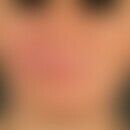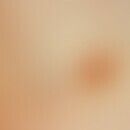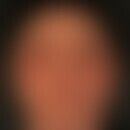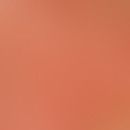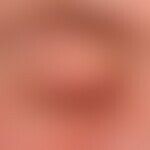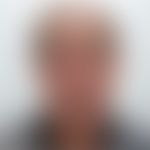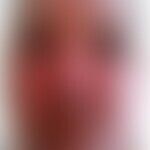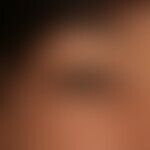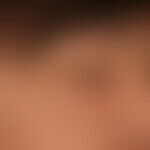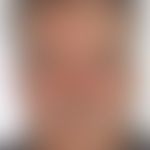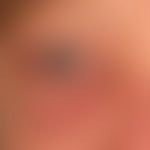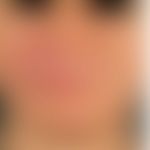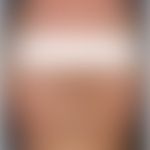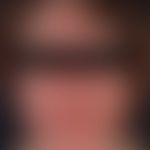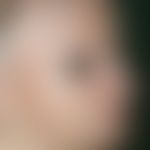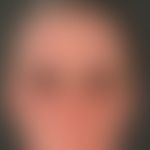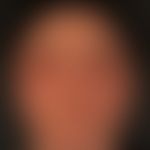Synonym(s)
HistoryThis section has been translated automatically.
Robert Degos, 1957
DefinitionThis section has been translated automatically.
Chronic persistent, homogeneous, red to deep red, symmetrical (bilateral) swelling of the face accompanied by a mild to moderate feeling of tension. The etiology is unknown. An asymmetrical distribution pattern is less common.
Initially, the swelling is reversible. Over the course of months/years, the swelling becomes increasingly firm. There are generally no restrictions to the general condition. Systemic signs of inflammation are absent. Associations with other diseases (e.g. chronic inflammatory bowel diseases are not certain). Some authors classify Morbihan's disease as a rare, "edematous variant" of rosacea.
You might also be interested in
Occurrence/EpidemiologyThis section has been translated automatically.
The disease is rare. The prevalence is unknown. In a large rosacea collective (n=204), around 1.5% of patients were found to have Morbihan's disease (Ghanadan A et al. 2023). In a meta-analysis comprising 96 studies and 166 patients, the ratio m:w=3:1 (van der Linden MM et al. 2023).
EtiopathogenesisThis section has been translated automatically.
As with rosacea, unknown. Associations with both acne and rosacea have been described. In some cases, however, such associations are completely absent.
ManifestationThis section has been translated automatically.
It mainly affects middle-aged white men and women (the average age in a slightly larger group was 58.8 years). The disease also occurs in people with a different skin color as well as in younger and older people.
LocalizationThis section has been translated automatically.
Preferentially affected are: cheek, nose, eyelids, forehead. Extrafacial involvement is not known (in contrast to rosacea).
ClinicThis section has been translated automatically.
Large, initially inconstant, later persistent, diffuse and blurred, cushion-like swelling and redness of the face combined with an unpleasant feeling of tightness of the skin; itching is generally absent, as is pain. The swelling is typically symmetrical and bilaterally distributed, more rarely it is asymmetrical.
The swellings are initially succulently soft, later increasingly firm, also rough and cannot be pressed in.
Rosacea may be present at the same time, although this statement is based on casuistic individual reports. However, the swelling does not correlate with the severity of the rosacea.
It is not uncommon for the facial swelling to lead to persistent swelling of the eyelids, which is often regarded by patients as the real problem.
DiagnosticsThis section has been translated automatically.
The diagnosis is usually based on the characteristic clinical picture, whereby other diseases with a similar appearance must be excluded (see differential diagnosis below; see illustrations below). This requires a thorough clinical history, which should include questions about signs and symptoms of rosacea or acne as well as systemic complaints (fever, myopathy, acute phase proteins, ANA). A full physical examination is also essential, with particular attention paid to inspection of the lips and tongue (lingua plicata-DD: Melkersson-Rosenthal syndrome). In addition, a histopathological examination of the affected skin with specific staining (including immunohistology) and laboratory tests are recommended.
HistologyThis section has been translated automatically.
The histological picture is not specific. There are perivascular and periadnexial lymphocytic, histiocytic, neutrophilic and epithelioid cell infiltrates in the upper and middle dermis (section series necessary) as well as numerous mast cells. Characteristic features are dermal edema, dilated lymphatic vessels and the presence of mast cell clusters.
Demodex, sebaceous gland hyperplasia, mild perifollicular fibrosis, elastosis, mast cell accumulations, perilymphatic or intralymphatic epithelioid granulomas may also be found. The presence of epithelioid cell granulomas, which could be a possible cause of lymphatic obstruction and damage to the vessel walls, are also considered diagnostic clues. An increased number of mast cells seems to correlate in particular with a longer persistent disease.
DiagnosisThis section has been translated automatically.
The diagnosis of Morbihan's disease is based on the characteristic clinical features and the exclusion of inflammatory diseases with a similar appearance (van der Linden MM et al. 2023).
Differential diagnosisThis section has been translated automatically.
In acute symptoms:
- Systemic lupus erythematosus: the serologic systemic symptoms of SLE are absent, histology, immunohistology, antinuclear antibodies (ANA) positive.
- Acquired angioedema: history, the acuteity of these swellings speaks against Morbihan's disease. Angiotensin-converting enzyme (ACE), C1 esterase inhibitor (C1-INH), complement component 1q (C1q) and C4.
Acute erysipelas: Initial swelling with pain and fever
In chronic persistent swelling:
- Melkersson-Rosenthal syndrome (with the classic triad of symptoms: cheilitis granulomatosa, facial nerve palsy, lingua plicata, the distinction is not difficult. More difficult to exclude are the differently pronounced minus variants (see also orofacial granulomatosis, primary periocular) with recurrent unilateral or bilateral orofacial swellings (eyelid swellings tend to favor the rosacea variant).
- Cutaneous sarcoidosis: Clinic and histology are diagnostic.
- Dermatomyositis: medical history, physical examination of the skin, creatine kinase (CK).
- Plaque-like form of cutaneous mucinosis: 2.0 to 10.0 cm large or larger, single or multiple, red, mostly asymptomatic, moderately indurated, non-scaly plaques with a punched, follicle-emphasized surface (peau d`orange). Disease responds like REM syndrome to chloroquine.
- Acquired hypothyroidism in adulthood: sonography, destruction of thyroid tissue, e.g. after atrophic thyroiditis. Also exogenous factors: iatrogenic (treatment with thyreostatics, cytokines, lithium, post thyroid surgery, post radioiodine therapy), health behavior (extreme iodine and selenium deficiency); possible occurrence of periocular mucinous edema.
- Blepharochalasis syndrome: Recurrent swelling of the eyelids. The acute phase lasts from hours to days (on average 2 days). In this phase there is painless edema usually combined with erythema. The patient may also complain of a "red eye" and lacrimation.
- Chroniccontact dermatitis: medical history, physical examination of the skin, histology, epicutaneous testing (fragrances and preservatives in cosmetics).
- Chronicactinic dermatitis: medical history with evidence of sensitivity to lichen; itchy, light-accentuated eczema; histology.
- Dermatochalasis: In this "age-related condition", the inflammatory symptoms and changeability are generally absent. There is excess skin without an edematous component.
TherapyThis section has been translated automatically.
Pronounced resistance to therapy. In principle, a longer treatment period of at least 6 to 12 months must be planned for pharmacological treatments in order to be able to assess clinical effects!
Moderately good results are described with monotherapy with isotretinoin (e.g. Isotretinoin-ratiopharm; Acnenormin) 0.2-0.5 mg/kg bw/day as monotherapy (Heibel HD et al. 2020)
Alternative: combination of isotretinoin with the mast cell blocker ketotifen (e.g. Zaditen 1-2 mg/day).
Alternative: Combination of isotretinoin with the mast cell blocker ketotifen (e.g. zaditen 1-2 mg/day) and medium doses of corticosteroids (20-25 mg prednisolone equivalents).
Alternatively: tetracyclines (usually doxycycline or minocycline) possibly in combination with corticosteroids. The additional administration of systemic or intralesional corticosteroids to previous treatments may be advantageous.
Alternative: Clofazimine (e.g. Lampren) 4 times/week 100 mg p.o.
Alternative: Thalidomide 100 mg/day.
Alternative: diuretics - furosemide: 60 mg/day or spironolactone: 75 mg 2x/day(Messikh R et al. 2012).
Alternative: Omalizumab in usual dosage (Kafi P et al. 2019; Mazurek-Durlak Z et al. 2024)
Alternative: Tofacitinib in usual dosage (Li ZY et al. 2023)
Note: Additive manual lymphatic drainage is often recommended (Melnik B et al. 2018; van der Linden MM et al. 2023).
External therapyThis section has been translated automatically.
The use of brimonidine can be recommended.
In clinical trials, brimonidine gel had achieved significantly greater improvements in facial flushing in rosacea erythematosa than placebo. Own experience has been favourable! The gel is applied daily in a pea-sized amount to the affected areas. The effect is expected within 30 minutes (Prep. Mirvaso®).
Operative therapieThis section has been translated automatically.
In the case of cosmetically disfiguring persistent eyelid swelling, the only remaining option is corrective blepharoplasty surgery. In this indication, the relatively minor surgical procedure should not be delayed.
Note(s)This section has been translated automatically.
Morbihan disease is named after the Morbihan region in Brittany. Morbihan is Breton for small sea and refers to the bay of the Gulf of Morbihan. This disease was primarily described in Morbihan (Degos et al. 1957).
Case report(s)This section has been translated automatically.
Casustics (Cabral F et al. 2017): A 61-year-old Caucasian man reported a 20-year history of rosacea that had developed into an erythematous disease with painless and persistent facial edema over the last two years (see figure). He complained of a feeling of heat on his face and was dissatisfied with the cosmetic aspect. He did not report any visual complaints. He had previously been treated with oral isotretinoin for six months with a partial response while taking the medication and a relapse after stopping the medication. Laboratory tests were normal. Histopathologic examination revealed nonspecific findings. The patient started treatment with isotretinoin (20mg - 0.3mg/kg) and deflazacort (30mg), which showed an excellent therapeutic response after one month. Isotretinoin was maintained and the corticosteroid was discontinued after one month, with relapse occurring within a few days. Topical and later oral metronidazole were then administered. There was no improvement. The dose of isotretinoin was increased to 40 mg (0.5 mg/kg). This also brought no improvement. Finally, the systemic corticosteroid (deflazacort 30 mg/day) was restarted and isotretinoin was maintained at a dose of 20 mg/day, which led to a marked improvement in the erythema and lymphoedema of the face. Recommendation: discontinue medication slowly and gradually.
Morbihan's disease without a history of rosacea/acne:
A 30-year-old woman had persistent, asymptomatic, erythematous, symmetrical facial edema for 18 months. No flushing phenomena. She had previously been treated with doxycycline (100 mg/day for four months) for an alleged "rosacea", but without success. Dermatologic examination revealed erythematous, surface-smooth, solid flat erythematous swellings in the center of the forehead, eyelids, nose and cheeks. Otherwise, the patient was completely healthy and was not taking any medication. The laboratory investigations with immunological tests and quantiferon test as well as MRI of the eye sockets, chest X-ray, high-resolution computed tomography of the chest, X-ray of the skull and ultrasound examination of the abdomen were all within the normal range. Histopathology revealed dermal edema with perivascular, periadnexal, lymphohistiocytic infiltrates with single eosinophils. Abundant mast cells were described. No evidence of sebaceous gland hyperplasia, no evidence of Demodex folliculorum. The patient was treated with oral isotretinoin (20 mg/day for eight months), but the massive facial edema and erythema did not resolve. She then received oral corticosteroids (prednisolone, 20 mg/day for two months, followed by a dose reduction over three months), which initially led to a significant improvement, but to a rapid relapse after discontinuation of the steroid. The patient was switched to a low-dose long-term therapy with isotretinoin (10mg/day) in combination with ketotifen and prednisolone (10mg/day). The overall clinical findings improved significantly except for the disfiguring swelling of the eyelids. In the meantime, blepharoplasty was performed at the patient's insistence with satisfactory results.
LiteratureThis section has been translated automatically.
- Aboutaam A et al. (2018) Morbihan disease: treatment difficulties and diagnosis: a case report. Pan Afr Med J 30:226.
- Degos R et al. (1957) Nouveau cas d'oedème érythémateux faciale chronique. Bull Soc Franc Derm Syph 80: 257
- Ghanadan A et al. (2023) Clinicopathological Survey of 204 Rosacea Patients Regarding Rosacea Subgroups and Severity. Dermatol Pract Concept 13:e2023182.
- Heibel HD et al. (2020) Successful treatment of solid persistent facial edema with isotretinoin and compression therapy. JAAD Case Rep 6:755-757.
- Hölzle E et al (1995) Morbihan's disease - Chronic persistent erythema and edema of the face. Dermatology 46: 796-798
- Jansen T et al (1996) Morbus Morbihan. Act Dermatol 22: 161-163
- Jansen T et al. (1998) Persistent erythema and edema of the face associated with rosacea and lymph vessel dysplasia. Dermatology 49: 932-935
- Kafi P et al. (2019) Morbihan Syndrome Successfully Treated with Omalizumab. Acta Derm Venereol 99:677-678.
- Lenders D et al.(2023) Rosacea (Part 1, Etiology, Classification, Diagnostics): New aspects in diagnostics, classification and therapy. Dtsch Arztebl 120(27-28): DOI: 10.3238
- Mazurek-Durlak Z et al. (2024) Omalizumab in the treatment of Morbihan syndrome in an adolescent girl - case report and literature review. Allergol Immunopathol (Madr) 52:23-31.
- Megahed M et al. (2013) Morbihan's disease as a special form of rosacea. Dermatologist 64: 884-886
- Melnik B et al. (2018) Acne and rosacea. In: Braun-Falco`s Dermatology, Venereology Allergology G. Plewig et al. (Eds.) Springer Verlag S 1330
- Mazzatenta C et al. (1997) Solid persistent facial oedema (Morbihan's disease) following rosacea, successfully treated with isotretinoin and ketotifen. Br J Dermatol 137: 1020-1021
- Messikh R et al. (2012) Efficacy of diuretics in the treatment of Morbihan's disease: three cases.
- Ann Dermatol Venereol 139:559-563.
- Suzuki M et al.(2023) Morbihan syndrome. J Gen Intern Med 38:233.
- van der Linden MM et al. (2023) Diagnosis and Treatment of Morbihan's Disease: A Practical Approach based on Review of the Literature. J Clin Aesthet Dermatol 16:22-30.
Incoming links (8)
Angiosarcoma of the head and face skin; Ashtray syndrome; Cheilitis granulomatosa; Degos, robert; Facial swelling; Morbihan`s disease; Swelling of the eyelids; Tofacitinib;Outgoing links (23)
Angioedema acquired; Blepharochalasis syndrome; Brimonidine; Chloroquine; Chronic actinic dermatitis (overview); Chronic inflammatory bowel disease; Clofazimine; Contact dermatitis allergic; Dermatomyositis (overview); Diuretics; ... Show allDisclaimer
Please ask your physician for a reliable diagnosis. This website is only meant as a reference.
